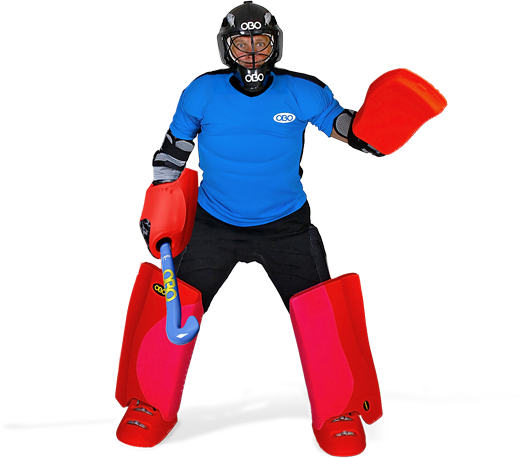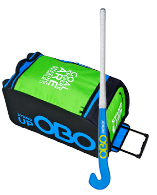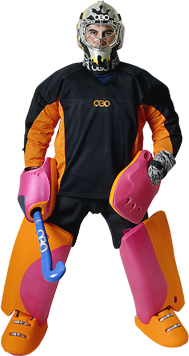KEEPERS RESOURCES

Kicking Drills

When you’re working on skills, it’s important that you isolate them so that you can evaluate technique and success. Skill work is different than situation work. When I work with keepers in situation drills, there are a number of skills they can use in a situation and be successful. When we work on skills, we’re focusing on specific form and results. Any time you work on skills, there are a couple of things to keep in mind.
You refine skills with consistent, quality, repetition. Consistent means that you’re giving a keeper the opportunity to play the same type of ball more than once. Ball machines are the best way for a keeper to be exposed to the same type of ball, but they’re not something that is available to every coach or keeper. If you don’t have a ball machine, you need the next best thing, human simulation. When you’re working on kicking skills, the next best thing is someone who can hit a level ball on the ground to a location over and over again. If you can’t find someone who can hit with accuracy, a push will have to do.

Practicing kicking without a ball machine.
Quality infers a lot of things. First is the quality of the surface that you’re training on. It makes no sense to worry about the consistency of the type of ball serviced to the keeper to play when the surface you’re training on makes every ball along the ground an adventure. Obviously, we’re talking about grass here. If you must train on grass, make sure the area you’re working on is as level as you can find. This is essential for kicking. This may mean that you work on kicking outside of the goal area (usually the most worn spot on a grass pitch). If your grass field is particularly rural, tennis courts or indoor gyms are excellent alternatives.
To ensure quality in repetitions, limit the number of repetitions in a set of the drill. In addition, allow the keeper time to recover into a ready position and allow sufficient rest time between sets. When you plan your practice drills, take in to consideration the fitness level of your keepers. If your keepers can’t do ten repetitions of a skill to a set without the skill breaking down, adjust the number of reps to your sets until his or her fitness improves. Fitness drills are different then skill drills.
Now for the drills…
One of the most basic kicking drills for keepers is kicking in pairs. Typically, this is the way I like to warm up for games and practice. Once I’ve warmed up, stretched and padded up, I’ll take another keeper and work on instep kicking over ten yards.
As we start to warm up, I’ll focus on moving to the ball so that I’m pushing off my plant leg and leading with my head when I make contact with my kicking leg. I focus on opening up and following through to my target. I’m specific with my target. I’m not just kicking at a keeper; I’m kicking to his left or right foot. I don’t want to have him move to get my kick, this is a warm up.

Note how the keeper is puching off with his plant leg and leading with his head.
How do I turn this into a drill? Exercises become drills when you can quantify skills. For beginning keepers, give them five minutes to see how many consecutive kicks they can put together. As keepers become more advanced, have the keeper who kicks call the foot the next keeper has to kick with. You can also modify the drill, where the keeper is calling the foot the other keeper has to kick to. Once keepers have warmed up, the next extension is to extend the distance they’re kicking to 25 yards. Once again, the same variations can apply, calling a foot to kick with or to.
In game situations, that can be problematic as you want to change the direction the ball came from. An easy way of remedying that situation is to add a third keeper to the kicking pair. With a third keeper, keepers now have to change the angle of their clear as they kick. This way they can work on crossover clears as well as instep kicks to change the angle of the ball. Usually, I’ll have keepers working in threes, kick in a V shape as opposed to a triangle. Keepers kicking in triangles can have a hard time keeping the ball in play long enough to get the number of repetitions needed for the drill to be productive. Having said that, it is physically possible for more skilled keepers to kick in a triangle and that way they all have to work on changing the angle of the ball.
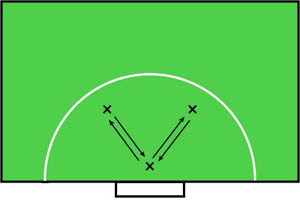
Kicking in a V.
It’s important that you have keepers practice kicking balls from where they’ll come in a game. If you want a keeper to work on coming up to clear crosses from the sides, start the ball from the wing, not at the edge of the circle. If you have a ball machine, set it up out that wide, if not have a player hitting crosses from about five yards in from the sideline. Footwork is key in kicking. If I set balls up too close to a keeper, I don’t reproduce the situation I want to incorporate in their game. I want my keeper to step up to the ball and clear accurately.
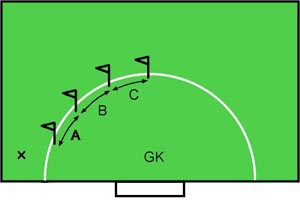
The gate set-up with the ball on the left, flip for right.
I like to give a keeper targets to clear to. We’ll set up cones four yards apart so that there are two or three gates they can clear through around the edge of the circle. I emphasise clear through. If a ball doesn’t leave the circle, it’s likely to come back even faster. There are a number of ways to reinforce that point. As a positive reinforcer (good for beginning keepers), we keep score for a set of ten balls, with keeper’s getting points for putting the ball through designated gates. To simulate game conditions, we’ll put forwards in the gates that are the most dangerous rebound areas and let them play those clears back to goal (a somewhat more negative reinforcer). Angles that I like to focus on for clearing from are marked below.
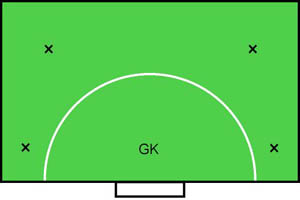
Places to cross from.
There are a million variations of these types of drills as keepers become more competent. I can put a keeper under pressure by having a player come on to deflect cross balls or simply stand by the keeper. It’s important to identify the skill you’re trying to get out of a drill.
I can consider the drills I’ve explained kicking drills because they are designed for the skill I want from the keeper. When you put field players into these drills, you add variables, and it becomes harder to reinforce through consistent repetition the skill you’ll get from the keeper. There’s nothing wrong with that as long as you’re dealing with a situation and a skill.

The gate set-up.
Good luck,
Jon
e-mail Jon
Please note that OBO together with Jon O’Haire hold copyright over any material appearing on tips pages. We welcome the printing and distribution of these tips, provided that they are not sold, or used for financial gain. This paragraph must appear on all printed or distributed copies. The photographs above must not be used in any form without express permission from Jon O’Haire.
Comments
Leave Your Comments Below

















